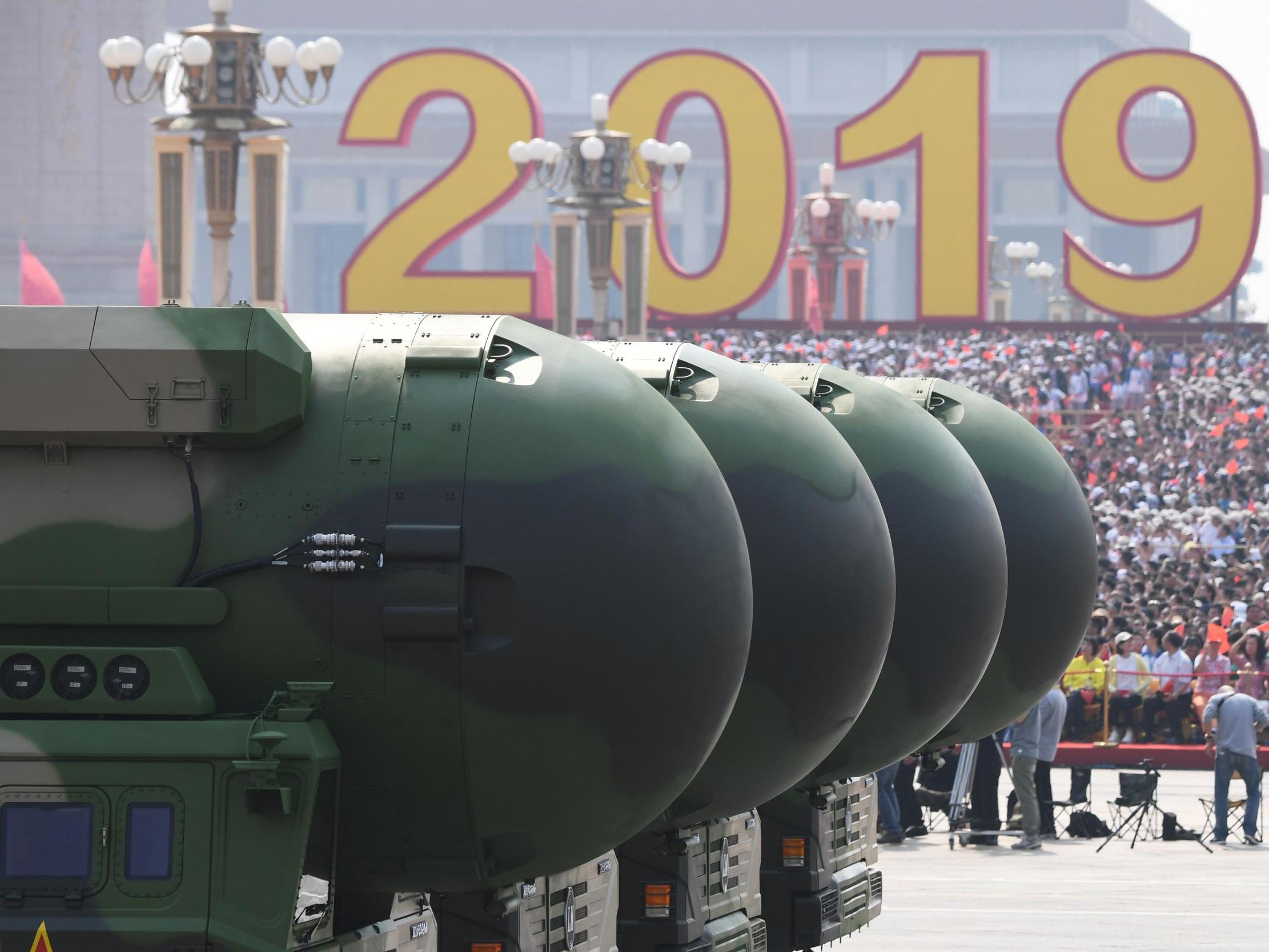China conducts rare public test launch of intercontinental ballistic missile
China tries to play down first test of its kind in 44 years as ‘routine’, but analysts say it sends a worrying message

Your support helps us to tell the story
From reproductive rights to climate change to Big Tech, The Independent is on the ground when the story is developing. Whether it's investigating the financials of Elon Musk's pro-Trump PAC or producing our latest documentary, 'The A Word', which shines a light on the American women fighting for reproductive rights, we know how important it is to parse out the facts from the messaging.
At such a critical moment in US history, we need reporters on the ground. Your donation allows us to keep sending journalists to speak to both sides of the story.
The Independent is trusted by Americans across the entire political spectrum. And unlike many other quality news outlets, we choose not to lock Americans out of our reporting and analysis with paywalls. We believe quality journalism should be available to everyone, paid for by those who can afford it.
Your support makes all the difference.China conducted the rare first public test of an intercontinental ballistic missile (ICBM) into the Pacific Ocean in more than four decades, a move that can aggravate tensions in the Asia-Pacific region.
The missile that can cross continents carried a dummy nuclear warhead as it was launched by the People’s Liberation Army Rocket Force (PLARF) at 8.44am Beijing time on Wednesday, the Chinese defence ministry announced.
It “accurately landed in the predetermined sea area” during what it called a “routine arrangement in our annual training plan”, it said.
It was China’s first publicly announced test of an ICBM in 44 years, occurring amid escalating tensions in the Asia-Pacific region, where Beijing is regularly involved in disputes with Japan, the Philippines, and Taiwan.

China conducted the first known test of an ICBM in May 1980, when a DF-5 missile took a flight of more than 9,000km. Since then, China is believed to have conducted most of its nuclear weapons tests underground.
The ministry said the test was not directed at any country or target and it “informed the countries concerned in advance”.
Beijing did not comment about the path or trajectory of the missile or where exactly in the “high seas of the Pacific Ocean” it fell after the successful launch.
A map published in Chinese newspapers at the time showed the target area as roughly a circle in the centre of a ring formed by the Solomon Islands, Nauru, the Gilbert Islands, Tuvalu, western Samoa, Fiji and the New Hebrides.
Analysts have said China usually carries out these tests within its own airspace.
Ankit Panda, Stanton Senior Fellow at the Carnegie Endowment for International Peace, said ICBM testing in the Pacific Ocean is not the standard operating procedure for PLARF these days.
“Most testing takes place over PRC territory,” he said on X, adding that it is “essentially the first time this has happened (and been announced as such) in a long time”.
“PRC statement description of this specific test as ‘routine’ and ‘annual’ seems odd given that they don’t do this sort thing either routinely or annually.”
Leif-Eric Easley, a professor at Ewha University in Seoul, said the “unusual” ICBM test serves to highlight its ability and readiness to strike the US mainland if it chose to do so.
“To Washington, the message is that direct intervention in a conflict across the Taiwan Strait would involve the American homeland being vulnerable to attack,” he said.
“To US allies in Asia, China’s provocative test, conducted during its expansive regional military exercises, demonstrates its capabilities to fight on multiple fronts simultaneously,” he said, underscoring the need for stronger international cooperation on security and arms control.
Singapore-based security analyst Alexander Neill said the test fit a pattern of China simultaneously “engaging and warning”.
“This move is designed to show in clear terms that the means of delivering its strategic deterrent is still functioning,” said Mr Neill, an adjunct fellow with Hawaii’s Pacific Forum think-tank.
Drew Thompson, a visiting research fellow at the Lee Kuan Yew School of Public Policy in Singapore, said “the launch is a powerful signal intended to intimidate everyone”.
“Timing is everything,” he wrote on X. “[China’s] statement claims the launch does not target any country, but there are high-levels of tension between China and Japan, Philippines, and of course perpetual tension with Taiwan.”
Japan reported no damage to its vessels in the region but said it would continue to analyse information on the movements of the Chinese military.
A Japan Coast Guard official said it had received a navigation warning from China on Monday for “space debris” in three zones in the South China Sea and the Pacific north of the Philippines’ Luzon island, and in the South Pacific, ahead of Wednesday’s test.
China’s most advanced and latest ICBM is known to be DF-41 with a range of up to 12,000–15,000km (7,460-9,320 miles), capable of reaching the US mainland. It first came into service in 2017 and has been displayed at the Beijing Exhibition Centre.
The operation range is more than the typical ICBM greater than 5,500km (3,420 miles).
According to Pentagon estimates, China has more than 500 operational nuclear warheads, out of which approximately 350 are ICBMs. It is expected to have over 1,000 warheads by 2030.
In comparison, the US and Russia have deployed 1,770 and 1,710 operational warheads, respectively.
The public acknowledgement of the ICBM test comes as the US remains the main global rival of China, although Japan, Taiwan, the Philippines and others have blamed it for territorial disputes in the Pacific and South China Sea with countries in the region.
In April, the US military deployed its mid-range capability (MRC) missile system, also known as the Typhon, to the Philippines, a move that has prompted Beijing government officials to complain about the weapon repeatedly – twice in the past week alone.
It was the first time the US deployed such a weapon in the Asia Pacific region since a 1987 arms control treaty between the US and the then-Soviet Union. The intermediate-range nuclear forces (INF) treaty banned the deployment of land-based missiles ranging from 500km to 5,500km (311-3,420 miles).
Join our commenting forum
Join thought-provoking conversations, follow other Independent readers and see their replies
Comments